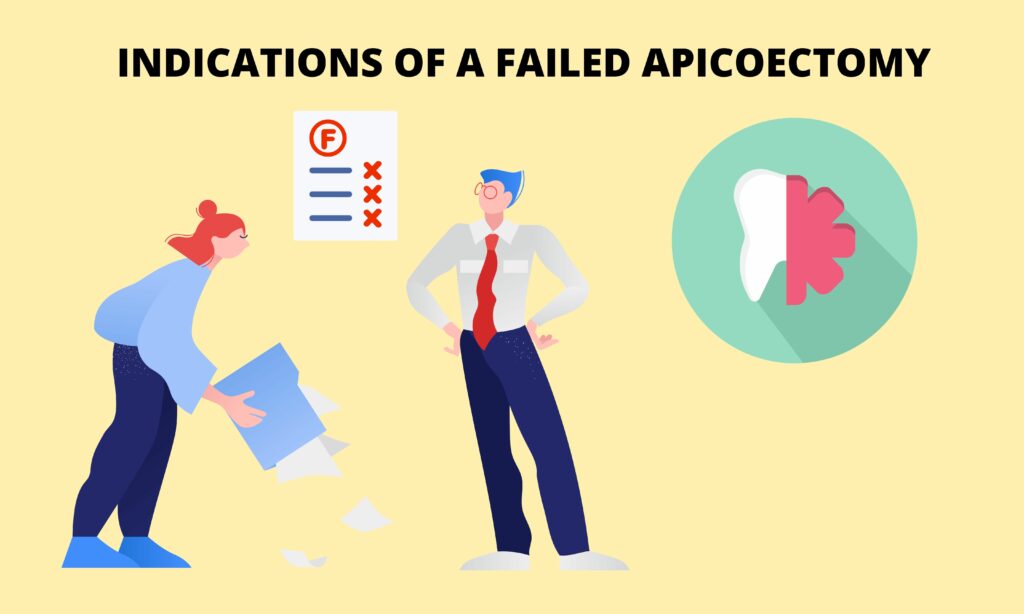
Apicoectomy, also known as root-end surgery, is a common dental procedure that is used to treat persistent pain and inflammation in the tooth root. While the procedure is generally safe and effective, some patients may experience apicoectomy pain after 6 months. Here’s what you need to know about the potential causes of ongoing pain and discomfort after an apicoectomy.
Apicoectomy pain after 6 months is not uncommon and can be caused by several factors.
- One possible cause is infection in the tooth root or surrounding tissues. If the infection was not completely removed during the initial procedure, it can continue to spread and cause pain and inflammation. In some cases, a second apicoectomy or a different type of dental procedure may be necessary to address the infection.
- Another possible cause of apicoectomy pain after 6 months is nerve damage. During the procedure, the dentist may need to remove a portion of the tooth root that is close to the nerve. While the nerve may eventually heal, it can take several months for the pain and sensitivity to subside. In some cases, nerve damage may be permanent and require additional treatment to manage the pain.
Poor oral hygiene can also contribute to apicoectomy pain after 6 months. If the patient does not maintain good oral hygiene, bacteria can build up in the mouth and cause infection and inflammation in the tooth root. Regular brushing, flossing, and dental check-ups can help prevent infection and promote healing after an apicoectomy.
Finally, some patients may simply have a slow healing process. Everyone’s body is different, and some people may take longer to heal after an apicoectomy than others. In these cases, it’s important to follow the dentist’s instructions for post-operative care and give the body time to heal.
In conclusion, apicoectomy pain after 6 months can be caused by a variety of factors, including infection, nerve damage, poor oral hygiene, and a slow healing process. If you are experiencing ongoing pain and discomfort after an apicoectomy, it’s important to consult with your dentist to determine the underlying cause and develop an appropriate treatment plan. With proper care and treatment, most patients can expect to make a full recovery after an apicoectomy.
What is an apicoectomy, and who needs it?
An apicoectomy, also known as root-end surgery, is a dental procedure used to treat persistent pain and inflammation in the tooth root. It is often recommended when a root canal treatment is not successful in resolving the issue. The procedure involves removing the tip of the tooth root and any infected tissue in the surrounding area. While the goal of an apicoectomy is to eliminate the source of pain and inflammation, some patients may experience apicoectomy pain after 6 months.
Apicoectomy pain after 6 months is not uncommon and can be caused by several factors.
- One possible cause is the presence of an underlying infection. Even if the procedure was successful in removing the infected tissue initially, there may be a chance that some of the bacteria survived and continue to cause inflammation and pain. In these cases, further treatment may be necessary to fully eliminate the infection and alleviate the pain.
- Another possible cause of apicoectomy pain after 6 months is nerve damage. During the procedure, it is possible for the dentist to inadvertently damage the surrounding nerves, which can result in ongoing pain and discomfort. While nerve damage can be difficult to treat, there are some medications and therapies that can help manage the pain and improve the patient’s quality of life.
Poor oral hygiene can also contribute to apicoectomy pain after 6 months. If the patient does not maintain good oral hygiene, bacteria can build up in the mouth and cause infection and inflammation in the tooth root. Regular brushing, flossing, and dental check-ups can help prevent infection and promote healing after an apicoectomy.
Finally, some patients may simply have a slow healing process. Everyone’s body is different, and some people may take longer to heal after an apicoectomy than others. In these cases, it’s important to follow the dentist’s instructions for post-operative care and give the body time to heal. Pain and discomfort may gradually subside over time as the body continues to heal.
In conclusion, an apicoectomy is a dental procedure used to treat persistent pain and inflammation in the tooth root. While the goal of the procedure is to eliminate the source of pain and discomfort, some patients may experience apicoectomy pain after 6 months. Possible causes of ongoing pain and discomfort include underlying infection, nerve damage, poor oral hygiene, and a slow healing process. It’s important to consult with a dentist if you experience any pain or discomfort after an apicoectomy to determine the underlying cause and develop an appropriate treatment plan.
What are the risks and complications of apicoectomy?

An apicoectomy is generally considered a safe and effective dental procedure. However, as with any medical procedure, there are potential risks and complications associated with apicoectomy. One possible complication that some patients may experience is apicoectomy pain after 6 months, as we discussed earlier. But there are other risks to consider as well.
- Infection – One potential risk of apicoectomy is infection. Although the procedure is performed under sterile conditions, there is still a risk of infection following the surgery. Infection can cause pain, swelling, and other complications. Antibiotics may be prescribed to reduce the risk of infection, and it’s important for the patient to follow good oral hygiene practices to prevent infection.
- Nerve damage – Another possible complication of apicoectomy is nerve damage. During the procedure, the surrounding nerves can be damaged, which can lead to numbness, tingling, or pain in the area around the tooth. In most cases, the damage is temporary and will resolve on its own over time. However, in rare cases, permanent nerve damage can occur.
- Bleeding is another potential risk associated with apicoectomy. Although bleeding during the procedure is typically minimal, some patients may experience more bleeding than usual. In rare cases, bleeding can become severe and require additional medical attention.
In some cases, the apicoectomy procedure may not be successful in resolving the underlying dental issue, and the tooth may need to be extracted. This can be disappointing for patients who were hoping to save the tooth, but it is important to understand that apicoectomy is not always effective in all cases.
Finally, some patients may experience an allergic reaction to the anesthesia or other medications used during the procedure. This can cause symptoms such as rash, hives, or difficulty breathing. Patients should inform their dentist if they have any allergies or medical conditions that may affect the procedure.
In conclusion, while apicoectomy is generally considered a safe and effective dental procedure, there are potential risks and complications associated with the surgery. These can include infection, nerve damage, bleeding, and an unsuccessful outcome. Additionally, some patients may experience ongoing apicoectomy pain after 6 months. Patients should discuss any concerns or questions with their dentist before undergoing the procedure to ensure that they fully understand the potential risks and benefits.
Indications of a failed apicoectomy

While apicoectomy is generally a successful dental procedure, there are instances where the procedure may fail to alleviate the patient’s dental issues. One indication of a failed apicoectomy is ongoing apicoectomy pain after 6 months. While some pain and discomfort immediately following the procedure are normal, it should gradually improve over time. If the pain persists or worsens after several months, it may be an indication that the procedure was not successful.
Another indication of a failed apicoectomy is the persistence of the original symptoms that led to the procedure in the first place. For example, if the tooth was initially causing pain, swelling, or sensitivity, and these symptoms persist after the apicoectomy, it may be an indication that the procedure was not successful.
Additionally, a failed apicoectomy can lead to the development of new symptoms or complications. For example, the patient may experience a new infection or abscess in the area around the tooth. This can cause pain, swelling, and discomfort, and may require additional treatment.
In some cases, a failed apicoectomy may also result in damage to the surrounding teeth, gums, or jawbone. This can occur if the procedure was not performed correctly or if complications arise during the healing process.
If a patient suspects that their apicoectomy has failed, they should schedule a follow-up appointment with their dentist. The dentist will perform a thorough evaluation of the affected area, which may include X-rays or other imaging tests. Based on the results of the evaluation, the dentist may recommend additional treatment options, such as retreatment of the apicoectomy or tooth extraction.
In conclusion, ongoing apicoectomy pain after 6 months, the persistence of original symptoms, the development of new symptoms or complications, and damage to surrounding structures are all indications of a failed apicoectomy. Patients who suspect that their procedure has failed should schedule a follow-up appointment with their dentist to discuss further treatment options. Early detection and treatment of a failed apicoectomy can help prevent further complications and restore dental health.
FAQs
Q: Is it normal to have apicoectomy pain after 6 months?
A: No, it is not normal to experience ongoing pain after 6 months following an apicoectomy procedure. While some initial discomfort is expected, pain that persists or worsens after several months may be an indication of a failed procedure.
Q: How long does the recovery process take after an apicoectomy?
A: The recovery process after an apicoectomy varies from patient to patient. Generally, patients can expect to experience some discomfort and swelling immediately following the procedure, which should gradually improve over the following days and weeks. It may take several weeks or even months for the tooth and surrounding tissues to fully heal.
Q: Can a failed apicoectomy be fixed?
A: Yes, a failed apicoectomy can often be fixed through retreatment of the affected tooth or through alternative treatments such as tooth extraction.
Q: Are there any steps I can take to prevent a failed apicoectomy?
A: While there is no guaranteed way to prevent a failed apicoectomy, there are steps you can take to minimize your risk. Follow your dentist’s post-procedure instructions carefully, practice good oral hygiene, and avoid activities that could damage the affected tooth or the surrounding tissues.
Q: Is an apicoectomy the only option for treating a root canal infection?
A: No, an apicoectomy is one of several treatment options for a root canal infection. Other options may include retreatment of the root canal or extraction of the affected tooth. Your dentist can help you determine which option is best for your individual case.
Takeaway
In conclusion, apicoectomy is a relatively common dental procedure that can help to save a tooth that has a persistent infection or other issues with the root canal. While the procedure can be successful in many cases, there is a risk of complications, including ongoing pain after 6 months.
If you have undergone an apicoectomy and are experiencing ongoing pain or discomfort, it is important to contact your dentist as soon as possible. Delaying treatment could increase your risk of further complications or even tooth loss.
When it comes to preventing a failed apicoectomy, there are steps you can take to minimize your risk. This includes following your dentist’s post-procedure instructions carefully, practicing good oral hygiene, and avoiding activities that could damage the affected tooth or surrounding tissues.
If a failed apicoectomy does occur, it is important to know that there are treatment options available. Depending on the specifics of your case, your dentist may recommend retreatment of the affected tooth or alternative treatments such as extraction.
Ultimately, if you are considering an apicoectomy or have already undergone the procedure, it is important to keep a close eye on any pain or discomfort you experience. While some initial discomfort is normal, ongoing pain after 6 months could be a sign of a failed procedure. By working closely with your dentist and taking steps to prevent complications, you can help to ensure the best possible outcome for your dental health.